| 1 | Crowned false boa |
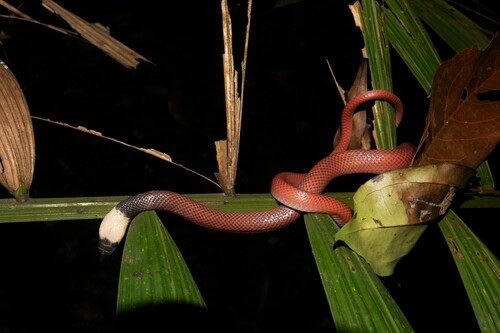
An easily recognizable Peruvian snake, which reaches a maximum of 109cm. Crowned false boas (Pseudoboa coronata) have never killed a human on record, and tend to thrash wildly and wrap tightly around your hand when picked up.
This snake has one feature which allows it to survive in Peru’s swarming jungles: flexibility. They inhabit rainforests, but are also comfortable in disturbed forests and rural gardens. They’re active during both day and night. They’re not restricted to one food type which they might be outcompeted for, as they can prey on lizards, mammals, swamp eels, and fellow snakes alike. Confirmed prey of the crowned false boa include giant ameivas, black-headed centipede snakes, and Cuzco tegus.
Crowned false boas spend most of their time on the ground, amid small rainforest shrubs and rotting logs covered in moss. They also climb onto low branches on occasion, if subtle scent trails lead them upwards.
This species begins life as a bright-reddish pink, before becoming purely red in adulthood, with a strong black head and white neck collar. Crowned false boas are regarded as only mildly venomous, capable of disabling their lizard prey, but mainly bouncing off humans. However, their Costa Rican cousin Neuwied’s false boa (Pseudoboa neuwiedi) turned out to be surprisingly dangerous in a 2018 study, with proteolytic qualities nearly matching a Bothrops pitviper. Therefore, if there’s any Peruvian snake which is secretly deadlier than anyone realizes, it’s the crowned false boa.
| 2 | Mountain sipo |
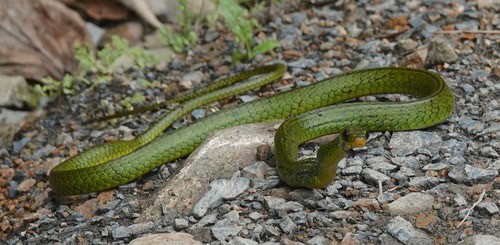
A moderately sized non-venomous snake which reaches a maximum of 157cm. Mountain sipos (Chironius monticola) closely follow the Andes mountain range in their territory, curving in a long line from northern Paraguay through Peru to Colombia. In Peru, they live on the forested eastern slopes of the Andes, at altitudes ranging from 200-3000 metres. Another of their names is the Andean whipsnake.
Energy is the reason this snake has survived Peru’s rainforests. Mountain sipos are fast-moving, curious, inquisitive, and will stab at anyone who crosses their path. Compared to their cousins like the South American sipo, they’re only semi-arboreal (tree-dwelling). However, they’re experts at weaving through small tangled bushes, and emerging from the opposite side holding an unexplained frog in their mouth. They’re even capable of underwater foraging, searching amid jumbled rocks in forest streams. One of their strangest tricks is body-bending, crinkling into strange shapes to resemble a fallen branch.
Large eyes, a green body and moving mainly along the ground are hallmarks for this species. Their diet is varied, including lizards and frogs such as Zurucuchu robber frogs. They appear in cloud forests and drier forests, but tend to prefer forest margins and clearings adjacent to forests.
| 3 | Desert lancehead |
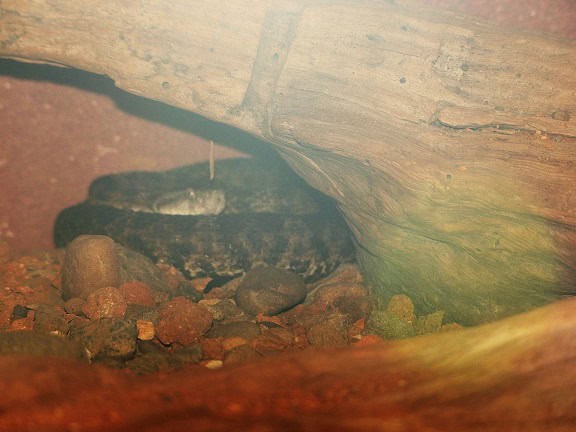
Peru isn’t all swarming jungles, as there’s a large arid zone to the west of the Andes. One of the venomous species you’ll find here is the desert lancehead (Bothrops pictus), part of the 48 member Bothrops family which includes the infamous fer-de-lance. Desert lanceheads inhabit Peru exclusively, in a large territory stretching down the Pacific coast, up to altitudes of 1800 metres in the western Andes.
Desert lanceheads are found in arid hills, rocky river valleys and desert areas with plenty of thickets. Despite being a lethal pitviper, they’re confirmed to be preyed on by black-chested buzzard eagles and must take great care to disguise themselves.
A study from 1990 to 1998 involved 23 bite victims admitted to Cayetano Hospital, and found that swelling, bruising and blistering were the most common symptoms. One patient suffered kidney injury, but none died, with 75% receiving antivenom.
Bothrops pictus has a strongly anticoagulant venom. A 1988 study on dogs a 40% reduction in fibrinogen, the backbone of healthy blood clotting. Its venom contains a rare enzyme called pictobin, and another new toxin was discovered in 2023 – Pictolysin-III. This cleaved through fibrinogen and even targeted the mitochondrial core of cells. This sounds horrific, but scientists deemed it promising for cancer treatment.
| 4 | Bate’s tree boa |
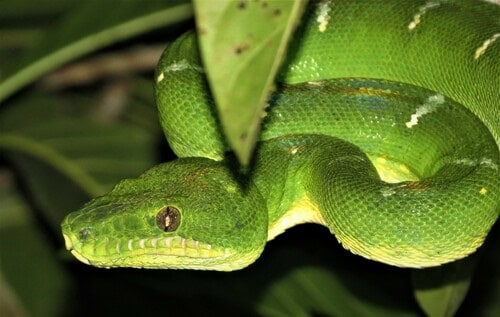
This large boa spends virtually all its life on tree branches, only straying to the ground in extreme circumstances. This a close relative of the emerald tree boa (Corallus caninus), a species which inhabits northern Brazil, Suriname and Guyana, while Bate’s tree boas inhabit a larger swathe of the Amazon further south, including Peru on the eastern slopes of the Andes.
Bate’s tree boas (Corallus batesii) prey mainly on rodents, which they explode towards in a sudden lunge that contradicts their normally sluggish appearance. Despite being non-venomous, Bate’s tree boas have fangs close to 2 inches long, which they use to hook onto prey, before applying their inescapable coils.
Rainforests are the best place to find this species in Peru; you won’t find them in a hotel garden. Originally, the emerald tree boa was a giant species covering the whole Amazon. Bate’s tree boa was only officially born in 2009, after a genetic difference of 3.1-16.2% was found between those further south.
At first glance they look identical, but there’s several subtle differences. Compared to Corallus caninus further north, Bate’s tree boa has an increased number of scales on the snout, and they sometimes have fused white blotches that form a consistent stripe, which Corallus caninus never has. They also have a mean of 18.1 (0-38) smudged dark blotches on their sides, while Corallus caninus has far fewer at a mean of 1.3 (0-11).
| 5 | William’s tree snake |
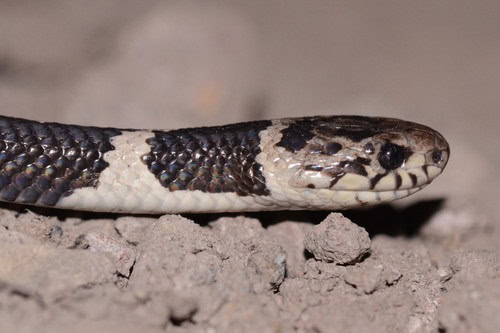
This black and white snake lives west of the Andes, and is endemic to Peru, occurring nowhere else. This snake is easily recognizable, as it has no colours on its body other than sharply contrasting domino shades.
William’s tree snake (Dipsas williamsi) is most commonly found in dry shrublands, sometimes near well populated towns. It’s mainly found in Lima and Ancash departments, and has a huge elevational range, occurring from sea level up to 2990 metres, and possibly 3626 metres, a larger range than almost any other Dipsas member. At higher elevations, it appears in dry steppe bushland, which is above the fog line from the Pacific ocean, and hence receives less moisture than areas lower down.
This is a fairly small snake (though not tiny), as the largest female ever measured 71.8cm, and the largest male 56.3cm. With a compressed body, they’re believed to be semi-arboreal, perhaps climbing up bushes and resting on their thin fingers of branches.
William’s tree snake was originally part of the Sibonymorphus genus, which ceased to exist when all its members were transferred to the preexisting Dipsas group (which now has over 30 members). Another member in western Peru is Dipsas vagrans, but this is less vividly black and white, with brown tinges. Little is known about its diet, as in the one study conducted, the remains were too heavily digested.
| 6 | Andean pitviper |
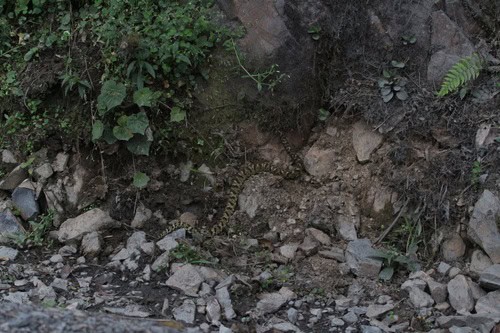
Have you ever considered visiting Machu Pichu? There’s been controversy lately over indigenous people blocking the tourist paths, accusing visitors of disrespecting the land, but even if you are granted access, there’s another obstacle to contend with: the Andean lancehead (Bothrocophis andianus). This is confirmed to dwell in the forested outskirts of the ancient historic site.
As the name suggests, Andean pitvipers exclusively inhabit the western slopes of the Andes, at elevations of 1800-3300 metres (Machu Pichu lies at 2430m). They range from southern Peru, through a large stretch of southwest Bolivia, hugging the mountains closely. Bothrocophias andianus is virtually never found away from forest. According to a 2019 study, it especially favours the darkest, most humid and overgrown forests, while its pitviper neighbor Bothrops monsignifer preferred more open and sunny forests.
Andean pitvipers are mainly nocturnal, though they travel during day occasionally. They may block your hiking trail, or they may coil tightly within a hollow log while you walk past unknowingly a few feet away. While they stick to the ground mainly, they’ve also been spotted coiled up on tree trunks 3 metres high.
A 2012 study on mice found typical viper symptoms, including haemorrhaging and swelling, but equal lethality to the infamous common lancehead. Either jump over Bothrocophias andianus or give up and turn back (number 2 is wisest).
| 7 | Striped sharpnose snake |
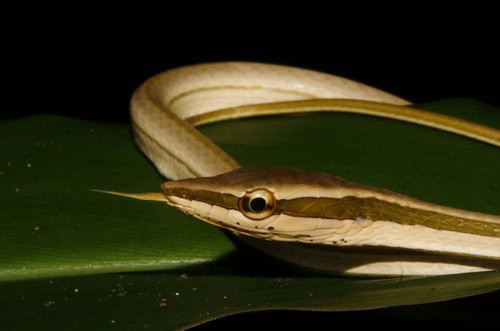
Part of the two member Xenoxybelis family. This is closely related to the southern sharpnose snake of Bolivia, but is easily the more common of the two.
Striped sharpnose snakes inhabit Peru east of the Andes, and are also found in eastern Ecuador and a swathe of Amazonian northwest Brazil. This is a green, branch-dwelling snake like several of its neighbours, but is easy to distinguish. First is the unusually pointed nose and face. Second is the sharply contrasting grey-green parallel stripes on its body, with the grey often exceeding the green. Their tongue and eyes are also green, with a round pupil. This species is active by day, and its favoured hunting method is to dangle from a branch with its body fastened, to snag prey from the forest floor.
A 2019 study concluded that sharpnose snakes have a positive correlation with tree cover, preferring dense closed canopy forests rather than human-altered disturbed forests with log piles lying around. To find the striped sharpnose snake, you must battle into the most untouched forests of Peru. This species has a venom, but its effects in humans are a mystery.
| 8 | Peru slender snake |
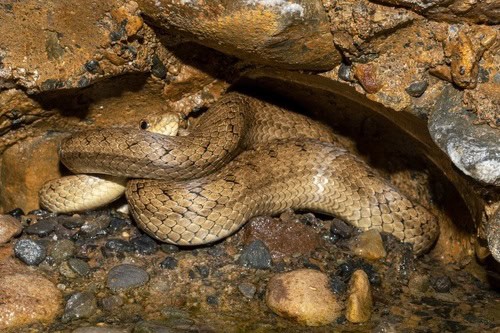
The third species of our list to inhabit western Peru. The Peruvian slender snake (Tachymenis peruviana) lives only west of the Andes in the dry zone, where sightings are abundant. They’re also found in Chile to the south, where they’re one of just 7 snake species.
Peruvian slender snakes live down to 1800 meters, but also as high as 4400m, making them one of the highest altitude snakes in the Americas. They have strategies for survival at this altitude, such as constantly sunning themselves on bare slopes to increase their bodily heat reserves. Their habitats include open areas like high altitude grassland and shrubland, and the thickly vegetated shores of marshes at lower altitudes. This species lords it over the Bothrops pitvipers in the rainforests below, and may just win a battle with them. They were long assumed to be non-venomous, but at least one human fatality has occurred from a Tachmenis peruviana bite. This is one of the easiest Peruvian snakes to underestimate.
Peruvian slender snakes feed on frogs or lizards, depending on location. If their home is a near a stream, frogs will dominate. If they reside on rocky mountain slopes, lizards will rule. Peruvian slender snakes reach a maximum of 66cm, and average at 40cm.
| 9 | South American elegant racer |
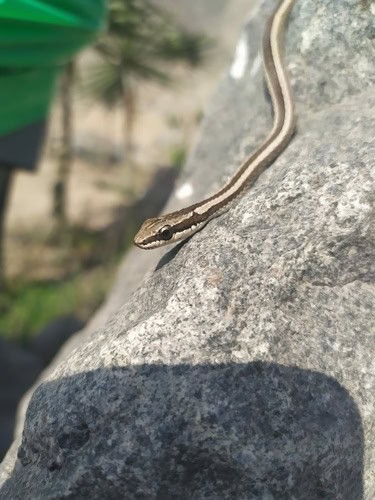
Another western Peruvian species, which just crosses the border into northern Chile, and southern Ecuador to the north. The South American elegant racer (Pseudalsophis elegans) is the only member of the 10-member Pseudalsophis family not to inhabit the Galapagos islands. They inhabit arid coastal regions, where they prey on lizards such as the Peru desert tegu (Dicrodon guttulatum).
Pseudalsophis elegans is also found in dry woodland and dry savannah areas. They stick to the ground rather than tree branches, and are a day-faring snake. Like the desert lancehead, they’re confirmed prey for the black-chested buzzard eagle. In fact, this bird was seen hunting a desert lancehead just 4 minutes after swallowing the racer, while perched on a tara tree. Being more arid and open than the jungled east, the snakes of western Peru may have more to fear from swooping birds overhead.
South American elegant racers also feed on the Pacific iguana family (Microlophus), like their Galapagos island cousins. This snake often hides in rock crevices, and has large eyes, covering almost half the width of the head. Pseudalsophis elegans is non-venomous and reaches a maximum of 77cm.
| 10 | Langsdorff’s coral snake |
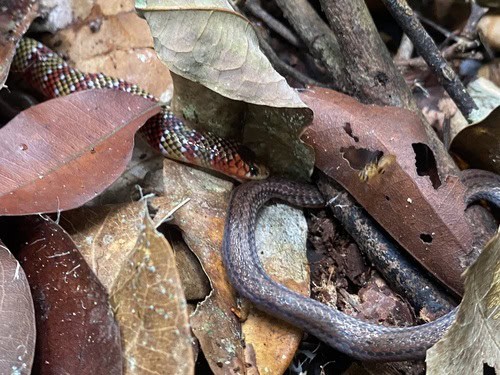
One of the most poorly researched coral snakes in the entire family, across all its 82 members. Langsdorrf’s coral snakes (Micrurus langsdorffi) are only found in the deepest rainforests. They’re particularly common in northern Peru, adjacent Ecuador and extreme western Brazil, though they’re never regularly encountered.
In appearance, this is easily one of the most unusual coral snakes. It appears in various strange morphs, including maroon-white, red-yellow-white, and tan-white-pink. Others have more black choking out the red. Depending on the morph, Langsdorff’s coral snake has a strong tendency to grow blacker with age (ontogenetic melanism).
This is a small coral snake, at an average of 40cm and a maximum so far of 85cm. This snake is barely researched at all. So far, the two prey items recorded in its diet have been fellow snakes, similarly to other coral snakes. The photo above also shows it eating an unidentified snake.
Langsdorff’s coral snake has smooth, glossy scales with round eyes. Coral snakes are best known for their neurotoxic venom, but there’s zero data for Langsdorff’s coral snake. Some of its morphs are truly fantastical. See here, here and here to witness the huge variety.
